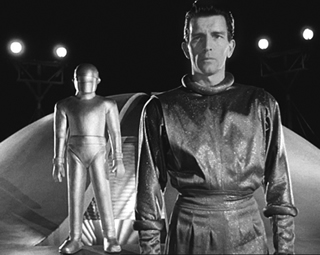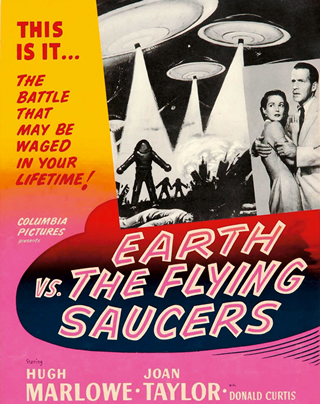It Came from Outer Space - Page 2
 |
|
|
 |
|
|
 |
|
|
The stories and artwork were quality stuff. “About 50 of Ray Bradbury’s stories, including The Martian Chronicles, were adapted by [editor, writer, and artist] Al Feldstein in the EC comic books Weird Science and Weird Fantasy,” says Joe Pilati, himself a child of the ‘50s, an early publisher of fan magazines (called ‘fanzines’), and an expert on comic books. “Bradbury was delighted with EC, and his name appeared prominently on the covers.”
Although most adults in that era weren’t buying comics, some of them had been enhancing the sc-fi ethos with highly publicized reports of flying saucers, assumed to be spacecraft from other worlds. UFO sightings had begun with one Kenneth Arnold in 1947, and continued with the report of a fallen saucer near Roswell, New Mexico that same year, later retracted. Sightings continued throughout the ‘50s, and would eventually inspire the 1956 film Earth vs. the Flying Saucers.
Pilati notes that the 1950s, “besides being the time when comic fandom emerged out of science-fiction fandom, were also the real heyday of 25- and 50-cent science-fiction magazines.” These included Astounding Science Fiction, Amazing Stories, Galaxy Science Fiction, and The Magazine of Fantasy & Science Fiction—titlesthat, despite being referred to as ‘pulp,’ published such visionaries as novelists Robert Heinlein and Fred Pohl. “His gift,” Gorsch says of Heinlein, “was being able to write about fantastic things, or things that haven’t yet happened, in this really reasonable, realistic way.”
Hollywood, too, was looking for new fantasies. Before the War, a steady stream of horror films had been produced, but in the 1940s “you didn’t see much horror, and you didn’t see hardly any science fiction,” notes John Stanley, journalist, author, and long-time host of Creature Features, which screened horror and sci-fi B-movies for nostalgic Bay Area TV audiences in the late ‘70s and early ‘80s.
Sci-fi was expanded significantly beyond the short serial form in 1951, notes Stanley, “when you had two classic movies, the first such movies I ever saw: The Thing from Another World, the Howard Hawks classic novel; and The Day the Earth Stood Still.”
Based on the sensational novella, Who Goes There?, by John W. Campbell, Jr., The Thing brought to the screen one of the recurring themes of mid-century sci-fi: grotesque creature as rampaging enemy against mankind. This particular creature, which had an Arctic science team screaming on camera and audiences of all ages screaming in their seats, was a tall vegetal humanoid (played by the future star of TV’s Gunsmoke, James Arness) on a mission of terror.




